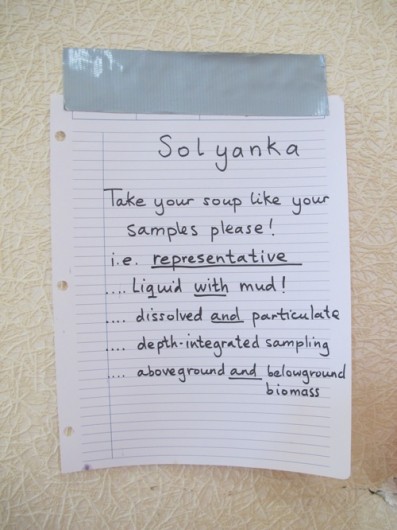
Take your soup like your samples…
Spending every waking (and sleeping) moment with like-minded ecologists really allows us students to come into our own as scientific beings. We take our soup like our samples, show and admire graphs of new data at dinner, rank things on a scale of “bio-radness,” and happily sacrifice our bodies and our sanity to hoards of mosquitoes to set up experiments or take samples (and no matter how swollen our hands are, we’ll do it again tomorrow).
The overarching characteristic of the group is curiosity. Everyone is inquisitive, and as time passes the level of interest does not drop – as projects develop and data rolls in, people seem to become more excited, and their findings lead to even more questions. Those of us with aquatic interests hear about terrestrial projects and go out into the field to experience them first hand, and vice versa.
I am interested in linkages between terrestrial and aquatic systems. My project will look at why old carbon stored in permafrost soils is so much easier for microorganisms to degrade than modern carbon, focusing on ice wedges as the potential cause. Ice wedges are essentially frozen water that has trickled down through cracks in the permafrost. Over time, more water that comes in freezes and forces the cracks to become larger, eventually forming huge ice wedges. When the air warms, ice wedges melt and mix with thawed permafrost, forming small streams. Last year, the aquatic survey sampled an ice wedge and found that it was very high in enzyme activity, which helps break down complex molecules. Following this, I expect old carbon mixed with ice wedge water to be more easily broken down than old carbon mixed with Kolyma river water. I added different ratios of ice wedge water to Kolyma river water and mixed them with old carbon to test this hypothesis by measuring enzyme activity, microbial activity and the diversity of the microbial community.

Duvannyi Yar ice wedge
My ice wedge and old carbon sample sites are at Duvannyi Yar, a stretch of permafrost cliffs along the Kolyma containing carbon that is tens of thousands of years old. Interspersed throughout these soil cliffs are massive ice wedges, several of which were used as samples in my project. Several days ago a tugboat towed the barge to Duvannyi Yar. It was exciting to get the barge in motion, get out of the lab and get on the water for an extended period of time. After a night traveling up the Kolyma we arrived to ice wedges and permafrost abounding, and spent hours weaving our way up and down the steep cliffs in search of mammoth, bison and horse bones. My best find was a mammoth hipbone covered in mosses and lichens hosting a small earthworm community.
After only a few days back, we depart for the tundra tonight! The diversity of ecosystems we are able to experience in this remote part of the world is truly incredible. And despite the rain today, I’m sure this adventure will be just as amazing as our last.




Comments(2)-
-
Lisa Dowdy says
July 18, 2012 at 9:50 pmThis is truly fascinating…even for your non-science geek mom!! 🙂 These are life adventures that you’ll never forget, not to mention how the findings will help scientists understand more about how our planet is changing along with our climate. Onward ho!!
Steve Dowdy says
July 19, 2012 at 1:00 amIce Wedges, Mosquitos, Mammoth bones, Frozen Tundra, what the…. I thought you were surfing in Indo for the past month!!!???
Sounds like it’s Great Fun to be a scientist!